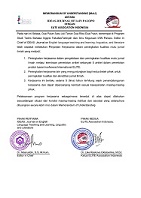Features of Women's Language Used by Kamala Khan in Ms. Marvel TV Series: A Sociolinguistics Study
DOI:
https://doi.org/10.24256/ideas.v12i2.5029Keywords:
Women’s language, women’s language features, gender, Ms. Marvel, Kamala KhanAbstract
This research aimed to identify the women’s language features used by Kamala Khan in the TV series Ms. Marvel (2022) based on the theory of women’s language proposed by Lakoff (1975). It was conducted using the descriptive qualitative method. To collect the data, the researcher watched the TV series several times and noted the utterances Kamala Khan produced that used women’s language features in an observation list. Based on the data collected by the researcher, in all six episodes of the TV series Ms. Marvel (2022), Kamala Khan used women’s language features 180 times in the 971 utterances she produced. The researcher found that 9 out of 10 women’s language features, as described by Lakoff (1975), were used by Kamala Khan in her utterances. Those features are lexical hedges or fillers (65), rising intonation on declaratives (33), “superpolite” forms (29), tag questions (16), avoidance of strong swear words (13), emphatic stress (10), intensifiers (9), “hypercorrect” grammar (3), and “empty” adjectives (3). Lexical hedges or fillers are the most frequent women’s language features used by Kamala Khan in Ms. Marvel (2022). Meanwhile, precise color terms did not occur in any of Kamala Khan’s utterances.
References
Bogdan, R., & Biklen, S. K. (2007). Qualitative research for education: An introduction to theories and methods (5th ed.). Pearson A & B.
Carroll, N. (1990). The image of women in film: A defense of a paradigm. The Journal of Aesthetics and Art Criticism, 48(4), 349. https://doi.org/10.2307/431572
Coates, J. (2016). Women, men, and language: A sociolinguistic account of gender differences in language (Third edition). Routledge.
Dewanty, M. (2020). Jo March’s language in Gerwig’s Little Women movie. https://repository.usd.ac.id/38253/
El Arbi, A., & Fallah, B. (directors). (2022, June 6). Ms. Marvel [Audiovisual]. Disney+. https://www.hotstar.com/id/shows/ms-marvel/1260098459
Gauntlett, D. (2008). Media, gender, and identity: An introduction (2. ed.). Routledge.
Holmes, J., & Wilson, N. (2022). An introduction to sociolinguistics (6th ed.). Routledge. https://doi.org/10.4324/9780367821852
Ismayanti, D., Said, Y. R., Usman, N., & Nur, M. I. (2024). The Students Ability in Translating Newspaper Headlines into English: A Case Study. IDEAS: Journal on English Language Teaching and Learning, Linguistics and Literature, 12(1), 108-131.
Knight, G. L. (2010). Female action heroes: A guide to women in comics, video games, film, and television. Greenwood.
Lakoff, R. (1975). Language and woman’s place. Harper & Row.
Lakoff, R. (2004). Language and woman’s place: Text and commentaries (M. Bucholtz, Ed.; Rev. and expanded ed.). Oxford University Press.
Litosseliti, L. (2013). Gender and language: Theory and practice (2nd ed.). Routledge.
Lorber, J., & Farrell, S. A. (1991). The social construction of gender. SAGE Publications.
Masruddin, M., Amir, F., Langaji, A., & Rusdiansyah, R. (2023). Conceptualizing linguistic politeness in light of age. International Journal of Society, Culture & Language, 11(3), 41-55.
Masruddin, Hartina, S., Arifin, M. A., & Langaji, A. (2024). Flipped learning: facilitating student engagement through repeated instruction and direct feedback. Cogent Education, 11(1), 2412500.
Miles, M. B., Huberman, A. M., & Saldaña, J. (2014). Qualitative data analysis: A methods sourcebook (Third edition). SAGE Publications, Inc.
Naovaratthanakorn, P. (2018). A critical discourse analysis of women’s language features used in an animated movie.
Rahadiyanti, I. (2020). Women's language features in Tennessee Williams’ A Streetcar Named Desire. Vivid: Journal of Language and Literature, 9(2), 86–92. https://doi.org/10.25077/vj.9.2.86-92.2020
Septiari, N. L. P. E., Sedeng, I. N., & Beratha, L. S. (2022). Women’s language is used by female characters in the Wonder Woman movie. LITERA: Jurnal Litera Bahasa Dan Sastra, 8(2), 116–123.
Sihotang, C. B. (2022). Women’s language features are used by the female characters in the Little Women movie. http://repository.usd.ac.id/44471/
Sudarto, M. A. (2020). Women’s Linguistic Features Used By The Superheroine In Captain Marvel Film (Doctoral dissertation, UNIVERSITAS AIRLANGGA).
Talbot, M. (2020). Language and gender (3rd ed.). Polity Press.
Trudgill, P. (2000). Sociolinguistics: An introduction to language and society (4th ed.). Penguin Books.
Downloads
Published
Issue
Section
Citation Check
License
Copyright (c) 2025 Shanya Putri Faiziah Pribadi S, Eliwarti Eliwarti, Indah Tri Purwanti

This work is licensed under a Creative Commons Attribution-ShareAlike 4.0 International License.
Authors retain copyright and grant the journal right of first publication with the work simultaneously licensed under an Attribution-ShareAlike 4.0 International (CC BY-SA 4.0) that allows others to share the work with an acknowledgement of the work's authorship and initial publication in this journal.
Authors are able to enter into separate, additional contractual arrangements for the non-exclusive distribution of the journal's published version of the work (e.g., post it to an institutional repository or publish it in a book), with an acknowledgement of its initial publication in this journal.
Authors are permitted and encouraged to post their work online (e.g., in institutional repositories or on their website) prior to and during the submission process, as it can lead to productive exchanges, as well as earlier and greater citation of published work (See the Effect of Open Access)



